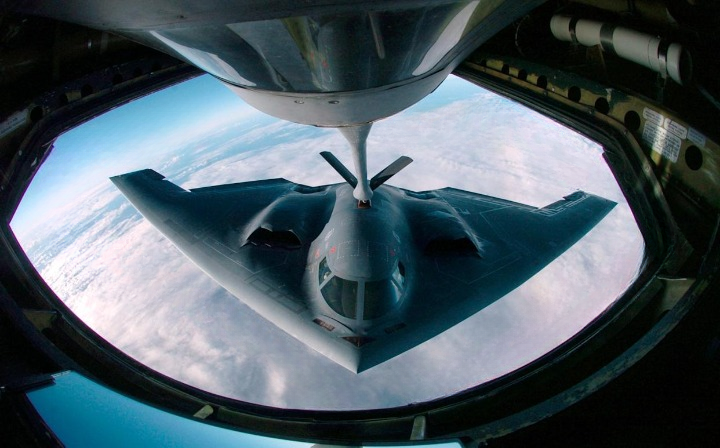In a feat rarely seen in modern aviation, the U.S. Air Force executed a 37-hour nonstop B-2 Spirit sortie from Whiteman Air Force Base, Missouri, penetrating Iranian airspace and then returning home. Far more than a test of range, the mission underscored America’s stealth reach, technical precision, and human stamina—with no reliance on overseas staging bases.
This operation was historic not only for its duration but for the seamless integration of logistics, training, and aerospace engineering. It spotlighted how far aerial warfare has evolved: pushing the limits of both machine and crew in the name of strategic deterrence.
The B-2 on a Global Tour
Stealth, Reach, and the Bombers’ Itinerary
The B-2 Spirit—famously dubbed the “stealth bomber”—is engineered to slip past the most advanced air defenses while carrying heavy munitions. On this mission, two B-2 aircraft launched from Missouri, journeyed across continents, overflew adversarial airspace, refueled in midair multiple times, struck a target, and returned unharmed—without once landing. Their course: Whiteman AFB → Iranian territory → back to Missouri.
The target for this mission was reportedly a deeply buried facility tied to Iran’s defense or weapons infrastructure. While much of the precise details were classified, the message was unmistakable: the United States can execute undetected, long-range precision strikes without relying on foreign basing.
Rather than simply an act of force, this was also a demonstration, a rehearsal of capabilities—and perhaps a subtle deterrent to adversaries.
Inside the B-2 Cockpit: Operating at the Edge
Constrained Quarters, Complex Duties
The B-2 cockpit is compact and austere. Only two pilots sit side by side, managing nearly every aspect of the mission together. Although the layout is minimalist, it is optimized for extreme-duration missions:
- Rest nook – A small rear area allows brief rest cycles.
- Rations & warming – A microwave or heating system lets crews reheat small meals.
- Sanitation – A basic toilet, functional but far from comfortable.
- Mental sustenance – Minimal entertainment; pilots lean heavily on conversation, data streams, and checklists to keep alert.
Pilots alternate tasks: when one flies, the other monitors systems, plans ahead, or takes micro-breaks. But in critical moments—tank refueling, target ingress, egress—both must remain fully vigilant.
One veteran pilot described it thus: “It’s like inhabiting a machine that never sleeps. Every click, every vibration, every instrument reading is alive with meaning. You cannot afford to drift.”
Fatigue, Focus, and Flow
Operating at 50,000 feet over an extended period is not merely a technical exercise—it is a sustained psychological and physiological ordeal. Fatigue is a constant adversary. To counter it, the Air Force tailors sleep, nutrition, and mental preparation programs for bomber crews well before launch.
Pilots adjust their sleep cycles, hydrate vigilantly, and eat balanced meals rich in slow-burn energy sources. During the sortie, caffeine is allowed—but sparingly—to avoid sudden crashes in alertness. Small, frequent meals help maintain energy, and simple movements—like calf stretches or hand flexes—are encouraged to preserve circulation.
As an Air Force flight surgeon put it: “You can’t autopilot the human brain. Discipline, training, and mental control are your greatest tools hour after hour.” In truth, while the aircraft systems are advanced, the trickiest challenge remains: keeping human minds sharp through exhaustion, anomaly alerts, and mission stress.
Training for the Impossible
Simulators, Drills, and Realism
No crew embarks on such a mission without years of preparation. Prospective B-2 pilots endure rigorous simulator regimes that mimic everything from high-altitude environmental changes to system failures, cockpit alerts, and weapons release dynamics. Some simulations last 24 hours or more—forcing crews to test rest cycles, nutrition strategies, emergency responses, and system malfunctions under fatigue stress.
In these immersive exercises, crews practice midair refueling, evading radar lock, and executing precise bombing runs. Over time, they internalize decision protocols under duress.
Yet, as retired Lt. Gen. Steven L. Basham observed, simulations reach limits. “When the weapons bay doors open, you feel it. The plane shifts. It’s then that you realize this is not a rehearsal.” The visceral sensations of a live mission—pressure shifts, structural stresses, ambient noise—are irreplicable in even the most advanced simulator.
Earning the Right to Fly the B-2
Not every pilot becomes a stealth bomber aviator. Selection is stringent, combining technical aptitude, mental resilience, and a track record of operational excellence. After selection, pilots work through progressively harder training phases, mastering stealth doctrine, navigation under denied environments, networked mission systems, and rigorous emergency protocols.
Only after years in fighter or other bomber platforms—and ample performance under stress—do candidates earn the chance to pilot a B-2. Even then, a cautious progression of training flights, joint exercises, and low-risk missions must prove readiness before major strategic operations.
The Technology Behind the Mission
Stealth Design and Signature Management
The B-2 is more than an aircraft; it is the culmination of stealth innovation. Its sleek “flying wing” silhouette is sculpted to minimize radar reflections. Composite materials, careful edge alignment, radar-absorbent coatings, and internal weapons bays all contribute to a minuscule radar cross-section.
During this particular mission, the aircraft carried hardened-penetrator bombs designed to destroy bunkered underground targets. Dropping such heavy ordnance requires fine-tuned balance adjustments and precise flying to maintain stability. Only highly experienced crews can manage the instantaneous shifts when munitions release mid-flight.
Lt. Gen. Basham likened the experience to literally jettisoning part of the aircraft itself. The shift is instantaneous, requiring immediate compensation.
Range, Payload, and Systems Integration
The B-2 is unique in offering global reach via aerial refueling and stealthy strike capability in one platform. With support tankers (e.g., KC-135/KC-46), it can traverse continents without landing. Its payload capacity—up to around 40,000 pounds—enables it to carry a suite of precision munitions, including GPS-guided or penetrating bombs.
On this mission, real-time data links, satellite comms, and integration with other aircraft (such as F-35s) and command instruments enabled dynamic targeting updates, threat avoidance, and mission adaptation. The complexity is staggering: every fuel drop, every radio burst, every radar sweep had to be choreographed to preserve stealth and accuracy.
The Human Story: Pushing Limits in the Sky
Psychological and Physical Strains
Sustaining heightened alertness for nearly two full days is an extreme mental burden. Stressors include system warnings, threat alerts, navigation deviations, and pilot shifts. Maintaining morale, mental clarity, and mutual support becomes crucial.
Physically, long immobilization, micro-gravity shifts, dehydration, and disrupted circadian rhythms all take a toll. Pilots must resist the urge to “zone out” and instead regularly engage in light motion or stretching—even while strapped into the control seat.
Preflight Regimens and Mission Mindsets
Before launch, crews undergo personalized regimens: matching their sleep-wake cycles to expected mission hours, optimizing meals for endurance, and rehearsing emergency plans. Psychological support—briefings, resilience training, stress inoculation—is also integral.
Once airborne, every pilot keeps a strict self-monitoring regime. They plan rest windows, monitor cognitive signals of fatigue, and coordinate micro-breaks without jeopardizing mission continuity.
Despite machine autonomy and system support, the human brain remains the core driver of decision-making under uncertainty.
Historical Lineage and Evolution of Long-Range Strike
Precedents and Milestones
This 37-hour mission builds upon a legacy of daring long-range sorties. A notable precedent: during the Kosovo conflict (1999), B-2s flew nonstop from Missouri to Serbia and back—over 30 hours. Pilots recalled it as surreal: “You leave home, fight halfway across the planet, then return to the same base.”
Since then, B-2s have operated over Afghanistan, Iraq, Libya, and other theaters—often from U.S. soil—pushing the envelope of global strike capability.
Each mission refines doctrine, logistics, and system integration. The leap from past sorties to today’s quiet, undetected, complex penetration into Iranian airspace marks a new constellation in strategic reach.
A New Paradigm in Stealth and Reach
Past operations sometimes encountered traces of missile launches, radar warheads, or detectable signatures. In contrast, this mission appears to have gone without detection or engagement—a hallmark of modern stealth maturity.
According to Basham, in earlier decades “you’d see missile trails, radar returns, or flares.” Today, the mission unfolded in still radio silence. No interference, no alerts—just a ghostly traverse over contested skies.
Strategic and Psychological Significance
The Message in the Clouds
Beyond its technical achievement, the mission delivered a message to global audiences: the U.S. retains unmatched ability to penetrate hostile spaces without stepping into allied territory. For adversaries, it underscores vulnerability—even within heavily defended regions.
In public remarks, Vice President J.D. Vance framed it succinctly: “‘We can operate across the planet, undetected and unstoppable.’ That strategic capability alone alters how opponents envision conflict.”
Analysts suggest the mission served dual goals: advert deterrence and combat rehearsal. Penetrating Iran’s airspace without alerting defenses illustrates that even sophisticated radar networks remain vulnerable.
Although official sources declined to confirm the precise target, many assume it was a deeply buried military or nuclear-related installation—symbolic of America’s readiness to respond to emergent threats.
Strategic Effects and Escalation Control
The ability to strike undisclosed, hard-to-reach targets without forward basing reshapes deterrence theory. It reduces reliance on regional basing, limits escalation footprints, and complicates enemy defense planning.
Additionally, the mission likely yielded intelligence: signals data, radar response traces, electronic footprint mapping. These enrich future mission planning and adversary profiling.
From a psychological standpoint, stealth missions like this reinforce a sense of proliferation deterrence: in effect, the U.S. is signaling that distance and distance alone are no barrier to precision strike.
The Logistics of Global Reach
Refueling, Timing, and Coordination
No solo bomber flies 37 hours unattended. A constellation of tanker aircraft refueled the mission multiple times—timed to precise rendezvous windows. Simultaneously, satellite and ground-based communication relayed updates, weather data, threat assessments, and mission changes.
Every handoff, every communication packet, every fuel transfer moment had to be synchronous. A single misstep—a late arrival, communication lag, or refueling slip—could compromise stealth or time margin.
Mission Security and Operational Silence
What makes this mission exceptional is not just stealth design, but the operational discipline around silence. There were no engagements, no detection events, no emergency diversions. It was a masterclass in denial-of-presence: the aircraft simply were not seen, heard, or intercepted.
For decades, the Air Force has refined techniques in fuel path planning, radar cross-section management, link security, and real-time synchronization. Each mission sharpenens the doctrine for future strategic readiness.
Lessons Learned and Future Trajectories
Toward the B-21 and Beyond
This mission offers valuable lessons for next-gen stealth platforms like the B-21 Raider. Design advances may incorporate AI-enhanced navigation, more autonomous systems to reduce pilot workload, improved materials for signature suppression, and enhanced human-machine symbiosis.
The B-21 will likely expand upon what was proven here: deeper penetration, longer persistence, adaptive routing, and more autonomous lethality. Human crews may take on more supervisory roles, with machines handling lower-level tasks under stress.
Doctrine, Readiness, and Strategic Posture
As threats evolve—geographic dispersion, anti-access/area-denial systems, integrated air defenses—the ability to strike from home becomes ever more critical. This mission sets a benchmark: stealth, endurance, precision, and human resilience must all converge.
Military planners will dissect every data point—physiological logs, refueling timing, comms telemetry, radar silence traces—to update tactics, training, and contingency planning. Doctrine may shift from “can we get there” to “how invisibly can we operate for days.”
The Symbolism of Invisible Power
The B-2 Spirit is not simply a weapons platform: it is a symbol. Its value lies not only in what it can destroy, but in what its presence prevents. An aircraft that can cross the globe and return undetected becomes a deterrent in itself.
In volatile geopolitical climates, the existence of an invisible threat that can strike anywhere softens the calculus of aggression. It’s a reminder: power need not be loud to be effective.
Final Thoughts: A Milestone in Airpower
The 37-hour B-2 mission was more than a flight—it was a declaration. It juxtaposed human endurance, cutting-edge engineering, logistical orchestration, and strategic intent into a singular demonstration of capability.
From the pilots’ unwavering focus to the aircraft’s flawless performance, every element aligned to reshape what is considered possible in modern aerial warfare. The mission signals that America’s global reach is not constrained by geography—but defined by stealth, precision, and human resolve.
As analysts comb through lessons, one certainty emerges: this mission will be studied not just as an aviation achievement, but as the moment a new era of long-range deterrent and invisible power took firm hold.




